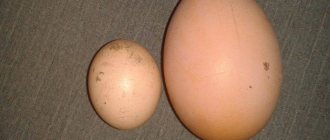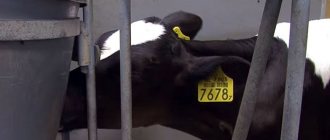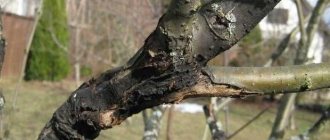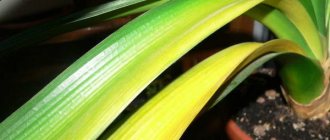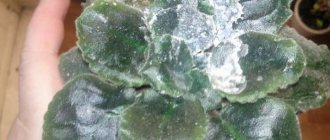Why does the bark come off?
A small number of detachments should not be a reason to panic. A tree with good immunity will absorb it on its own. But if the peeling of the bark of an apple tree is very rapid and abundant, it is worth finding the reason for this. Often these are poor care, illness or unsuitable weather conditions. You can learn more only if you take into account various factors and additional signs. How to treat this problem will already be clear from the factors that caused the detachments to appear.
The most common causes are frost damage or sunburn. Protecting an apple tree from this is quite simple. When caring, it is enough to take into account that whitewashing is carried out in autumn and spring.
Tree bark may fall off due to pests that feed on the tissue or overwinter under the bark. The cause may also be a number of diseases that spread throughout the tree or thrive in this warm place.
Prevention measures
To prevent the trunk with leaves from darkening, it is recommended to familiarize yourself with the basic preventive measures:
- You cannot plant apple trees near compost pits, as they cause the plants to weaken, become sick more often, and be attacked by insects.
- For planting, do not use areas with high groundwater levels. In such areas there is high soil moisture, which promotes the development of black cancer.
- When growing, trees are regularly pruned, during which crooked and weakened branches are removed. Also, when pruning, the crown is thinned out to improve lighting and ventilation.
- It is necessary to periodically feed and water the apple trees and clear the area of weeds. In mid-spring, the skeletal branches and trunk are whitened with lime to protect the plant from burns and parasites.
In young apple trees
Young apple trees can suffer from peeling bark for several reasons. In addition to the above, young apple trees suffer more than others from hungry pests in winter. Hares and mice are not averse to eating the bark of a young tree. And due to severe damage, the wood will peel off in large pieces. To avoid this, young trunks need to be insulated with a material that pests cannot handle.
Peeling of the bark of a young apple tree.
Factors influencing detachment
A thorough examination of the garden crop and a detailed study of splits, as well as other changes in the condition of the wood that accompany the damage, allow us to understand why cracks appeared on the tree bark, why it flakes off, flakes off and falls off.
Diseases
When the bark of an apple tree not only cracks, but also turns black and dries, and its structure is loose and covered with a brown-black coating, most likely these are the first signs of black cancer. It is caused by sooty fungus, and the disease instantly spreads throughout the tree.
When an infection occurs, not only the trunks become damaged, but also the fruits and foliage. Black cancer can destroy a garden crop in 3-4 years.
Animals and pests
If the bark of fruit trees is cracked and exposed, this is the first sign that it has been eaten by rodents or hares. Peeling wood in places where the bark peels off on the apple tree becomes a site of infection.
Tree bark also peels off due to damage from bark beetles. The pest penetrates through mechanical damage and wounds to where dead wood has burst, peeled off, or is lagging behind, and settles there. Most often it affects weakened and old fruit trees with reduced immunity.
The first signs of the pest's spread are the numerous burrows made by the beetle in places where the wood is peeling off.
Yellow lichen appears on fairly mature apple trees. The older the tree, the higher the risk of being affected by it. The place of its settlement is the trunk and branches. Contributing factors are high humidity and low temperatures.
If the apple tree is not cleared of lichen, it will soon cause the development of a fungus, which after some time will begin to decompose the tree bark.
Temperature changes
When the bark of an apple tree bursts and comes off without visible signs of a pest or disease, the damage may be caused by sharp temperature fluctuations day and night. This situation is especially common in the spring.
Cracks caused by exposure to temperature changes differ in description and nature of appearance from those that occur due to damage by parasites or diseases. Trunks and branches crack in the transverse direction.
The causes of cracking and peeling of wood are often severe frosts or, conversely, persistent heat. Low-winter-hardy trees grown in waterlogged soil or planted too deep are at risk.
Improper care
The cause of cracking in apple wood is also improper care of garden crops:
- lack of mineral elements and lack of moisture, while the bark bursts and falls off, and the ripening fruits dry out;
- improper pruning and poor subsequent disinfection of sections.
Often, during the rainy autumn season, the actively growing shoots of young apple trees become covered with cracks along the trunk. The reason for this is the lack of elasticity of wood during its rapid growth.
What is the treatment if the bark on the trunk of an apple tree peels off?
First of all, you will need to clean all the detachment areas and even those that are only slightly swollen. If you do this yourself, the process will be under control. The areas are cleared to the living, the wounds are covered with garden varnish. This is done even to prevent infection from getting into the wound. If the trunk is damaged more than half, then grafting with a bridge of young shoots will be required.
Stripping the bark of an apple tree.
If a hollow appears
How to seal a hollow in an apple tree is a real surgical operation. First, using a chisel, a chisel and a sharp knife, the hollow is cleared of rotten wood until it is healthy. After this, it is thoroughly disinfected with a 5% solution of ferrous sulfate. Then the hollow is filled with small crushed stone and filled with a solution prepared from 1 part cement and 2 - 3 parts sand. And after cleaning, small hollows can simply be plugged with a wooden plug. All this must be done carefully so that your “seal” does not protrude beyond the edges of the hollow.
If the bark peels off at the base of large branches
If longitudinal cracks appear in the bark of adult apple trees at the base of large branches, this is a manifestation of the effects of frost or bright sun shining from the snow. To avoid this, you need to whiten in the fall as high as possible along the trunk, up to the forks.
If the wounds are chaotic and with a large number of forks, then this may be evidence of pest activity. They need to be cleaned and sprayed with dichlorvos or insecticide. The top of the wound is covered with garden varnish. If the damage is large, then a mixture of resin, fat and paraffin is needed, and a patch of burlap is made on top.
How to help an apple tree with peeling bark
All dead or damaged bark is carefully cut off from the trunk of the apple tree. After this, the problem area is thoroughly cleaned until healthy wood appears.
Do not forget to preserve the cambium located along the edges of such stripping. Next, the problem area is treated with hydrogen peroxide or brilliant green.
And when it dries well, it is coated with oil paint made from natural drying oil.
Or the wound can be covered with liquid garden varnish. If you do everything correctly, then after some time the area you cleared will be overgrown with new bark.
Also, peeling of the bark on an apple tree may be due to the fact that a dangerous pest, the bark beetle, has settled on it.
You can determine that it is he who is harming the garden crop by carefully examining it.
If you touch the damaged bark, sawdust will begin to spill out from under it and from the holes in it.
If you remove a piece of damaged bark completely, then sometimes you can see the pest itself underneath it. In order to save the tree, remove all damaged bark and repeat all the steps that were described in detail above.
However, it often happens that due to the gardener’s oversight, the bark beetle severely damages the bark.
In this case, to save the plants, they resort to “bridge” grafting. Take cuttings from the same plant, and then they are grafted lower and higher than the damage.
Don't forget to treat the damaged area before doing this (see above). The same procedure is carried out if the bark of the plant has been severely damaged by hares or mice.
However, peeling of the bark can also occur if the crop is affected by anthracnose or black cancer.
But such dangerous diseases begin to develop only if the cortex is already injured. That is why you need to take good care of your apple tree and be sure to monitor the condition of its bark, trying to protect it from injury.
If the bark of an apple tree begins to peel off, this may indicate many diseases. The main thing is to recognize the problem in time and begin treatment. In this article you will learn about the reasons for the peeling of bark from a tree, about diseases that are dangerous for the apple tree and how to cope with them. The article will be useful not only for beginners, but also for experienced gardeners.
Measures to combat bark peeling in young apple trees
First of all, wounds on young apple trees need to be cleaned. Wood that has come loose must be removed and cleaned.
Small wounds:
- cleanse;
- lubricated with fatty pitch;
- apply a bandage.
If the wound is large:
- the damaged area is washed with potassium permanganate;
- dried;
- apply fabric with zircon;
- leave the bandage on for a day;
- remove the bandage and dry it again;
- Cover the wound with a special lubricant.
If the treatment is carried out in the fall, then the suture sites should be wrapped in polyethylene, and unwound in the spring and the treatment repeated if necessary.
At the old apple tree
If the tree is already quite mature, it needs to be carefully examined. You need to save an apple tree according to a certain algorithm:
- clean areas of bark;
- treat with iron sulfate;
- whitewash.
Whitewashing an apple tree.
Vitriol helps get rid of mycelium or any diseases that may appear in cracks. Open areas and severe damage are covered with ready-made garden varnish or prepared from fat and paraffin.
Mechanical treatment methods
Before we even talk about treating tree bark, you need to understand that examining its condition cannot be limited to just inspection. Each injury should be felt. If there are many foci of the disease, then you need to probe the entire tree. In one place on the apple tree, the cracked bark may peel off, the branches may become bare, and in another they may swell. It is important to find every damage. Next, you need to prepare the places where certain drugs will be applied.
Attention! It is necessary, if possible, to clean the bark at the sites of damage, this will make it possible to thoroughly treat each wound.
If the bark is damaged by disease
In a situation where the cause of damage to the apple tree bark is mold, then first you need to cut off the damaged branches. Because the mold that causes apple tree disease can affect the entire tree at once. If any area is missed, the tree is doomed to die within a few years. The mechanical method of treating an apple tree for mold cannot be done independently; it must be carried out in combination with chemical treatment of the wood.
You must always remember that an unkempt garden is always more susceptible to the spread of various infections. Dry branches and damaged areas are all good places for parasites to breed. Gardeners with well-kept gardens will not encounter moldy trees. Therefore, it is necessary not only to use some methods of combating lesions on the bark of trees, but also to take care of the entire territory of the garden.
Treatment of wood after damage by animals
When the bark of an apple tree is damaged by rodents, the flow of sap along the tree trunk is disrupted. When the cambium (layer of living cells) is destroyed, the apple tree will suffer and may die. The most effective way to save it is to graft a young shoot. To do this, you need to take a scion of an apple tree and plant it next to the damaged tree so that it can graft onto the bark. Preferably slightly above the damaged area. It is with the help of this young shoot that the sap flow of the apple tree will be restored.
Clean the cracked tree bark. It is better to tie loose pieces of bark back onto the damaged areas. Next, you should take garden pitch, or a mixture of manure (cow) and clay in equal proportions, and lubricate the damaged areas. You can use a special antibacterial composition. Afterwards, you need food-grade plastic film to wrap the processing area. It will retain moisture and help the cambium to recover.
Treatment after pests
Fruit tree pests most often mean bark beetles, which can infect an apple tree and multiply in areas where the bark begins to peel off. A tree damaged by such insects is also difficult to save without resorting to chemical treatment. But there are still mechanical methods of treating bark beetles. A trap or bait is often used for this. For example, cut branches of an apple tree should be placed away from the garden. Beetles are attracted to cut fresh wood and these branches become a breeding ground for them. About a month after summer, such a fire should be burned.
Fact!
Bark beetles are also easy to collect during the period when they reproduce. For this method to be effective, trees must be inspected constantly.
Damage from temperature changes
After a cold period and a change in temperature conditions, dead areas that fall off may be found on the bark of the apple tree. More often found at the base of knots. The color of the bark is always changed, and it looks drier. In these places, the exchange of nutrients in the tree becomes difficult, affecting its strength; the bark literally splits at the slightest touch.
To treat bark after frost, methods are used similar to those used for damage by rodents. Attention is also focused on restoring the structure of the tree bark. Even in such a situation, “bridges” from apple tree shoots can be planted in bare areas. They must be wound around the perimeter of the bare area on the trunk, pre-treated with vitriol (3%). The method is very effective, but takes time.
Actions for frostbites and sunburn
Frostbites occur in winter when sudden temperature changes occur. The bark peels off because after freezing there comes a period of above-zero temperatures, and then the bark freezes again. With the next increase in temperature, the bark comes off and will need to be processed. Clay putty, which is prepared from fatty clay and putty, will help. You can make mash from lime, clay and manure.
Burns appear in the spring from the bright sun. They need to be covered immediately. A lubricant made of lard and wax in a one-to-one ratio will help. If the wound is large, then a slightly different composition will be required: nigrol, wax and rosin. Instead of wax, paraffin or lard is suitable.
Treatment of fruit trees
Treatment is carried out by completely removing the swollen bark. Then the diseased area is covered with varnish. Larger damage must be covered with a clay composition. To prepare it you will need 1 kg of clay and 1 kg of ash. After thorough mixing, the mixture is applied to an open area of wood and wrapped with burlap in 1 layer.
If peeling is detected in the area of large branches and forks, the cause of the disease is disease. If cracks appear along the trunk on mature apple trees, the cause is sudden temperature changes at the end of winter - beginning of spring. To reduce the risk of this cracking, the lower part of the trunk is whitewashed before the start of winter. For the treatment of wounds the following is used: oleoresin; paraffin; fat; clay with ash.
If the bark comes off at the neck of the tree
Depending on how severe the damage is, procedures for saving the apple tree may vary. It is possible to rebuild the cover only if the damage occupies no more than half the area of the trunk.
There are a number of options to restore the bark:
- moisten the cloth in highly concentrated ash and close the wound;
- wrap with craft paper or baking parchment, wrap with rope on top;
- Wrap the wound area on top with film or roofing felt.
In the spring, in order for the damage to heal, you need to use the bridge grafting method.
Unfortunately, large wounds are very difficult to heal. It will take at least five years for the tree to recover. You can understand that the process has begun when the cadmium begins to linger. In some cases, it may be more prudent to cut the tree and graft in a young branch.
Nuances and questions from readers: actions if the bark peels off and...
This collection contains a list of actions to take in emergency situations. They are based on the experience of specialists and other gardeners.
Turns black
If under the bark detachments there are black depressed areas that look like they are scorched, then, most likely, it is no longer possible to save the apple tree. These symptoms are very similar to black cancer - a dangerous disease that is destructive.
Blackened apple tree.
Rotting
Rotten areas must be thoroughly cleaned. All rot is removed to a healthy place and treated with a fungicide to remove the infection. After this, the area is dried and coated with garden varnish or drying oil to close the wound.
There is a yellow lichen
The lichen itself is not very dangerous. It is better to remove dead areas of bark, spray the tree with a fungicide, and fill the wound with garden varnish.
There is a bark beetle
It is necessary to clean the places of moves and detachments. The trunk will have to be treated with Karbofos or Aversectin to remove the pest. To destroy all the beetles and larvae, you will also have to remove the trunk circle and process it.
Gets wet
Soaked and peeled bark must be completely removed. It is necessary to treat the wound with hydrogen peroxide to prevent the disease from spreading further. Then the area needs to be dried and sealed.
The apple tree is dying
If the damage is not very extensive, but it is already affecting the condition of the apple tree, resuscitation can begin. Grafting using young cuttings taken from this tree helps well. This method is called “bridge” because of its special shape.
Recommendations from experienced gardeners for emergencies
When the cortex is peeled off, phenomena are often discovered that indicate the development of serious diseases. In these cases, treating the apple tree requires a special approach.
Blackening
The effect of charred bark and wood indicates the disease of the apple tree with black cancer.
The causative agent of the disease is a fungus of the genus Neonectria galligena; its spores most often infect young shoots. Damaged fragments are characterized by the formation of necrosis and swelling. In addition, the fungus invades tissues and inside wood, forming a red-brown mycelium. In the central zone of the Russian Federation, damage to fruit crops by black cancer usually occurs in the fall. If peeling and blackening of the bark is observed throughout the apple tree, while the wounds look depressed and the branches are charred by fire, then it is pointless to restore the tree. Black cancer in its advanced form cannot be treated. In this situation, you can only try to save the young shoots by re-grafting them, but you cannot guarantee the desired result.
Rotting
To eliminate this problem, you will need to clean the rot-affected area down to healthy wood tissue and cambium. Afterwards, the wound must be thoroughly coated with a solution of one of the fungicides, and after the treated area has dried, with garden varnish. Semi-synthetic or natural drying oil will be an effective replacement for garden varnish.
Presence of lichen
The lichen itself does not cause any harm to the tree, but harmful microorganisms and insects like to settle under it. You can get rid of lichen using the stripping method, removing the dead bark underneath and treating the area with a fungicidal preparation.
Bark beetle invasion
The bark eaten by the pest is treated with a composition containing “Aversectin S” or “Karbofos”. In addition, all plant debris is removed from the garden area and burned.
Getting wet
The wet bark is stripped back to healthy wood. In order to prevent damage to the cambium, the edges of the damage are treated with hydrogen peroxide, then dried and coated with red lead prepared in real drying oil.
Small but dangerous defeat
In the case when the root system, trunk and other parts of the tree are still alive, but the risk of their death is quite high, the tree is saved by grafting a “bridge” constructed from young and healthy shoots taken from the same apple tree. The location of the graft must be below the wound; before the procedure, it is cleaned and coated with drying oil.
Proper care of the apple tree will prevent all possible problems. Fruit crops need high-quality insulation for the winter, which will protect it from frost, sun and rodents. In addition, the tree needs autumn and spring whitewashing, as well as preventive treatment with fungicides and insecticides.
Detachment of bark from a tree can occur for a number of reasons; to determine the actual cause, it is necessary to carefully analyze all factors. This approach will allow you to choose an effective treatment method.
Previous
Diseases
